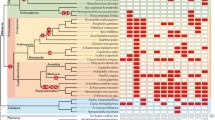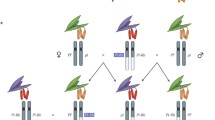Abstract
Paramutation refers to an allelic interaction, whereby the paramutagenic allele of a gene induces a heritable change of expression at a paramutable allele. The paramutated allele becomes paramutagenic itself. Paramutation is an example that acquired states of gene expression can be inherited. Originally discovered in plants, it can also occur in other organisms. It is mechanistically connected to important epigenetic regulatory pathways and potentially relevant for evolution and population genetics.
Similar content being viewed by others
Literatur
Bateson W, Pellew C (1915) On the genetics of “rogues” among culinary peas (Pisum sativum). J Genet 5:13–36
Brink RA (1958) Paramutation at the R locus in maize. Cold Spring Harb Symp Quant Biol 23:379–391
Coe EH (1959) A regular and continuing conversion-type phenomenon at the B-locus in maize. Proc Natl Acad Sci USA 45:828–832
Hagemann R (1958) Somatische Konversion bei Lycopersicon esculentum Mill. Zeitschr Vererbungslehre 89:587–613
Pilu R (2015) Paramutation phenomena in plants. Semin Cell Dev Biol 44:2–10
Gabriel JM, Hollick JB (2015) Paramutation in maize and related behaviors in metazoans. Semin Cell Dev Biol 44:11–21
Springer NM, McGinnis KM (2015) Paramutation in evolution, population genetics and breeding. Semin Cell Dev Biol 44:33–38
Chandler VL, Eggleston WB, Dorweiler JE (2000) Paramutation in maize. Plant Mol Biol 43:121–145
Hövel I, Pearson NA, Stam M (2015) Cis-acting determinants of paramutation. Semin Cell Dev Biol 44:22–32
Ronsseray S (2015) Paramutation phenomena in non-vertebrate animals. Semin Cell Dev Biol 44:39–46
Rassoulzadegan M, Cuzin F (2015) From paramutation to human disease: RNA-mediated heredity. Semin Cell Dev Biol 44:47–50
Tuite MF (2015) Yeast prions: paramutation at the protein level? Semin Cell Dev Biol 44:51–61
Gouil Q, Novak O, Baulcombe D (2015) SLTAB2 is the paramutated SULFUREA locus in tomato. bioRxiv, doi: http://dx.doi.org/10.1101/033605
Author information
Authors and Affiliations
Corresponding author
Additional information
Jasmin Bassler 2006–2010 Biotechnologiestudium an der Fachhochschule FH Campus Wien, Österreich. Diplomarbeit am Gregor Mendel Institut für Molekulare Pflanzenbiologie, Wien. 2010–2013 Studium der Publizistik- und Kommunikationswissenschaften an der Universität Wien. Seit 2012 Promotion im Doktoratskolleg Chromosome Dynamics am Gregor Mendel Institut für Molekulare Pflanzenbiologie.
Ortrun Mittelsten Scheid 1975–1985 Biologiestudium und Promotion an der Universität Hamburg. 1986–1987 Postdoc am Max-Planck-Institut für Zellbiologie, Ladenburg. 1988–1992 Postdoc an der ETH Zürich, Schweiz. 1992–2003 Postdoc am Friedrich Miescher Institut, Basel, Schweiz. Seit 2004 Gruppenleiterin am Gregor Mendel Institut für Molekulare Pflanzenbiologie, Wien, Österreich.
Rights and permissions
About this article
Cite this article
Bassler, J., Mittelsten Scheid, O. Paramutation: eine Begegnung mit bleibendem Eindruck. Biospektrum 22, 128–130 (2016). https://doi.org/10.1007/s12268-016-0663-6
Published:
Issue Date:
DOI: https://doi.org/10.1007/s12268-016-0663-6




